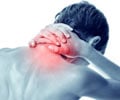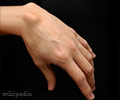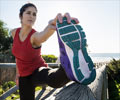Got a new pair of running shoes? Well, before you get down to taking them on the jogging track, here's a piece of information-running shoes are likely to damage knees,
Got a new pair of running shoes? Well, before you get down to taking them on the jogging track, here's a piece of information-running shoes are likely to damage knees, hips and ankles.
In a study, researchers compared the effects on knee, hip and ankle joint motions of running barefoot versus running in modern running shoes.They concluded that running shoes exerted more stress on these joints compared to running barefoot or walking in high-heeled shoes.
Sixty-eight healthy young adult runners (37 women), who run in typical, currently available running shoes, were selected from the general population.
None had any history of musculoskeletal injury and each ran at least 15 miles per week.
All runners were provided with a running shoe, selected for its neutral classification and design characteristics typical of most running footwear.
They observed each subject running barefoot and with shoes using a treadmill and a motion analysis system.
Advertisement
Disproportionately large increases were observed in the hip internal rotation torque and in the knee flexion and knee versus torques.
Advertisement
The findings confirmed that while the typical construction of modern-day running shoes provides good support and protection of the foot itself, one negative effect is the increased stress on each of the 3 lower extremity joints.
These increases are likely caused in large part by an elevated heel and increased material under the medial arch, both characteristic of today's running shoes.
"Remarkably, the effect of running shoes on knee joint torques during running (36pc-38pc increase) that the authors observed here is even greater than the effect that was reported earlier of high-heeled shoes during walking (20pc-26pc increase). Considering that lower extremity joint loading is of a significantly greater magnitude during running than is experienced during walking, the current findings indeed represent substantial biomechanical changes," said lead author D. Casey Kerrigan, JKM Technologies LLC, Charlottesville, VA, and co-investigators.
Kerrigan concluded: "Reducing joint torques with footwear completely to that of barefoot running, while providing meaningful footwear functions, especially compliance, should be the goal of new footwear designs." The study has been published in the latest issue of PM and R: The journal of injury, function and rehabilitation.
Source-ANI
TRI















